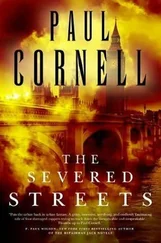From the morning Latonya Wallace was found, every detective who had surveyed the death scene asked himself why the killer would risk carrying the child’s body into the fenced rear yard of 718 Newington, then deposit it within sight and hearing of the back door. If the murderer had, in fact, managed to enter the rear of Newington Avenue undetected, why not leave the body in the common alley and flee? For that matter, why not leave the body in a yard closer to either end of the block-the only points at which the killer could have entered the alley? And why, above all, would the killer risk entering the fenced yard of an occupied home, then carry the body 40 feet and deposit it so close to the rear door? Other yards were more accessible and three of the rowhouses that backed up to the alley were obviously vacant shells. Why risk being seen or heard by the residents of 718 Newington when the body could just as easily be left in the yard of a house where plywood covered the windows and no occupant would ever peer out to witness the act?
Even before the old drunk from Newington Avenue had proven himself to be insufficient for murder, an answer began to take shape in the two detectives’ minds, an answer that dovetailed neatly with Landsman’s earliest theories.
From the first day, Landsman contended that the murder had in all likelihood occurred in a house or garage close to where the body was dumped. Then, in the early morning hours, the murderer carried the dead child into the alley, laid her at the door of 718 and fled. Most likely, Landsman had argued, the crime scene was in one of the houses on Callow, Park or Newington avenues, which backed up on the alley from three sides. And if the crime scene was not in the immediate block, then it was at most a block in any direction; the detectives could not envision a murderer, an unconcealed body in his arms, wandering across several blocks of his neighborhood when, for disposal purposes, one alley was as good as another.
There was, of course, a slim possibility that the murderer, fearful of driving very far with a dead girl’s body, had used a vehicle to bring the body a short distance to the alley behind Newington-a possibility that Landsman was considering in regard to the Fish Man, who lived blocks from the scene on Whitelock and therefore contradicted the working theory. One resident in 720 Newington had, in fact, told canvassing detectives that she had a vague memory of seeing headlights shine on her rear bedroom wall at four o’clock on the morning the body was discovered. But beyond that sleepy recollection, no resident recalled seeing a strange vehicle in the rear of Newington Avenue. In fact, with the exception of one man who often parked his Lincoln Continental in the rear yard of 716 Newington, no one could remember seeing any car or truck in the cramped back alley.
The new gospel of the Latonya Wallace case-with Edgerton as its author and Pellegrini, his first convert-accepted all those earlier arguments and yet seemed to explain the strange, illogical placement of the body: The killer had not come through the alley. Nor had the child been carried through the premises of 718 Newington-the obvious alternative. The elderly couple who lived at that address and discovered the body were well accounted for and their home had been checked carefully by detectives. No one believed that they were involved, nor was it possible that the body could have been carried through the house without their knowledge.
Only after looking at the scene from a dozen different angles did Edgerton seize on a third possibility: The killer had come from above.
A week ago, when the body was discovered, several detectives had walked up and down the metal fire stair that began on the roof of 718 Newington and descended two flights to the back yard, ending a few feet from the kitchen door and the death scene itself. The detectives checked the stairs for a blood trail or other trace evidence and found nothing. Edgerton and Ceruti had even climbed up to the single-story rear landings of nearby rowhouses to check old pieces of clothesline for comparison with the ligature marks on the child’s neck, but none of the men had given any systematic thought to the idea of rooftops. Only after a dozen visits to the scene did the idea begin to shape itself in Edgerton’s mind and on Sunday morning, three days after the discovery of the body, the detective began putting the theory to paper.
Edgerton taped two sheets of letter paper together and divided the space into sixteen long rectangles, each representing one of the sixteen adjoining rowhouses on the north side of Newington Avenue. In the center of the diagram, behind the rectangle marked 718, Edgerton crudely drew a small stickman to mark the location of the body. Then he indicated the location of the fire stairs at 718, extending from the rear yard to a second-floor landing and then the roof, as well as other fire stairs and ladders on other properties.
Ten of the sixteen rowhouses had direct access to the roof from inside. Latonya Wallace could have been lured into one of the homes on the north side of Newington, molested and murdered, then carried out one of the second-floor windows onto the flat, tar-covered landings above the rear additions. From there, using the fire stairs, the killer could have carried the body to the third-floor roofs, walked a short distance across the common roof and then descended the metal stair into the yard of 718 Newington. That theory alone could explain why the body was dumped near the back door in the fenced yard of 718 and why the killer did not take the lesser risk of leaving the body in the common alley, or a more accessible yard. From the ground, 718 Newington made no sense. But from the roof, 718 Newington was-by virtue of its secure, metal stair-one of the most accessible yards in the block.
On that same Sunday, Edgerton, Pellegrini and Landsman explored the tops of the Newington rowhouses, looking for evidence and trying to determine which houses had direct access to the roofs. The detectives checked the roof caps of each house and found all to be either sealed with tar or otherwise secure. But from the rear second-floor rooms of ten homes, an occupant could have crawled from the window and taken a fire stair or ladder to the roof.
Edgerton marked those homes-700, 702, 708, 710, 716, 720, 722, 724, 726 and 728-on a steno pad, noting as well that 710 and 722 were vacant buildings that had already been checked by detectives. He crossed those houses off, as well as 726 Newington, which had been renovated recently into one of those skylight-and-track-lighting yuppie wonders, the block’s sole concession to a decade-long campaign to attract homeowners and rebuild Reservoir Hill’s slum properties. That house was being prepared for sale and was unoccupied, leaving seven viable rowhouses with access to the roof.
On Tuesday, the new theory was granted even more credibility when Rich Garvey, reviewing the color photos from the death scene, noticed the black smudges on the child’s yellow print pants.
“Hey, Tom” he said, calling Pellegrini over to his desk. “Look at this black shit on her pants. Does that look like the usual kind of dirt to you?”
Pellegrini shook his head.
“Christ, whatever the hell that stuff is, the lab ought to be able to tell you something. It looks like it might be oil-based.”
Roofing tar, thought Pellegrini. He walked the photograph down to the fifth-floor crime laboratory to check it against the child’s clothes, which were being examined for hairs, fibers and other trace evidence. A chemical breakdown of the jet black smudges could take weeks or even months and might only yield the class characteristics of the substance. Pellegrini asked whether it could be determined if the stuff was petroleum-based or if it was at least consistent with roofing tar. Yes, he was told after a preliminary examination by the chemists, probably so, although a full analysis would take time.
Читать дальше












